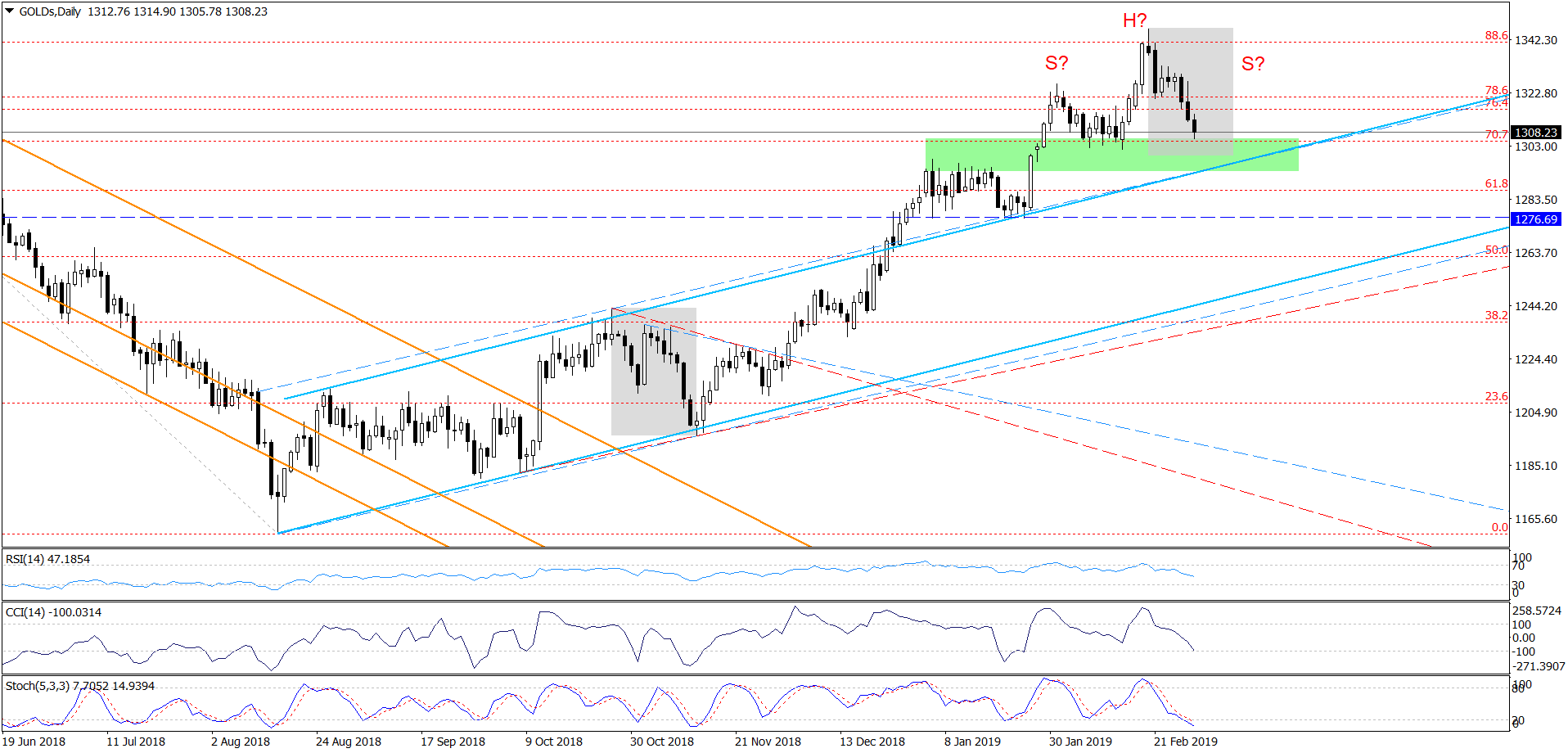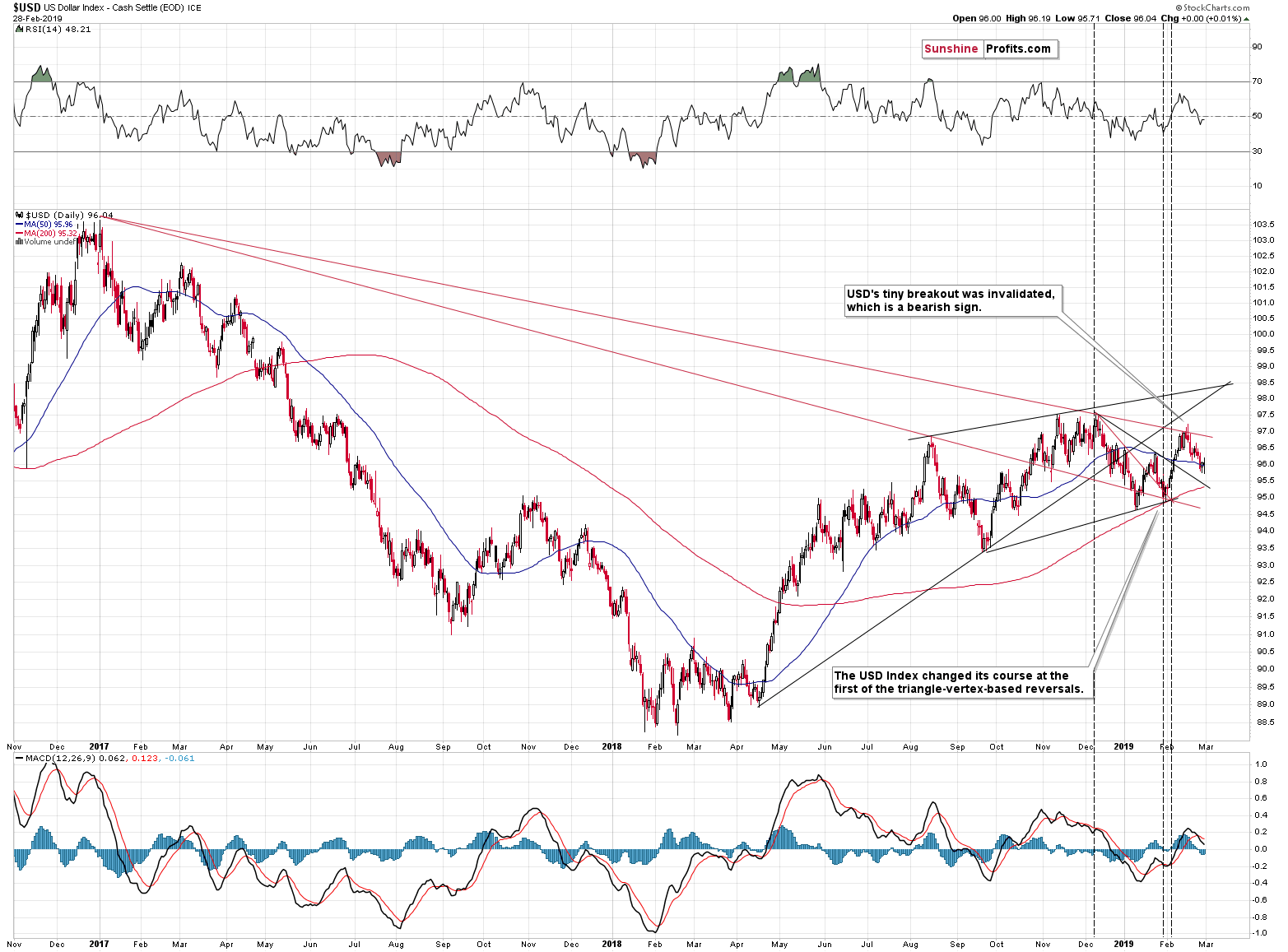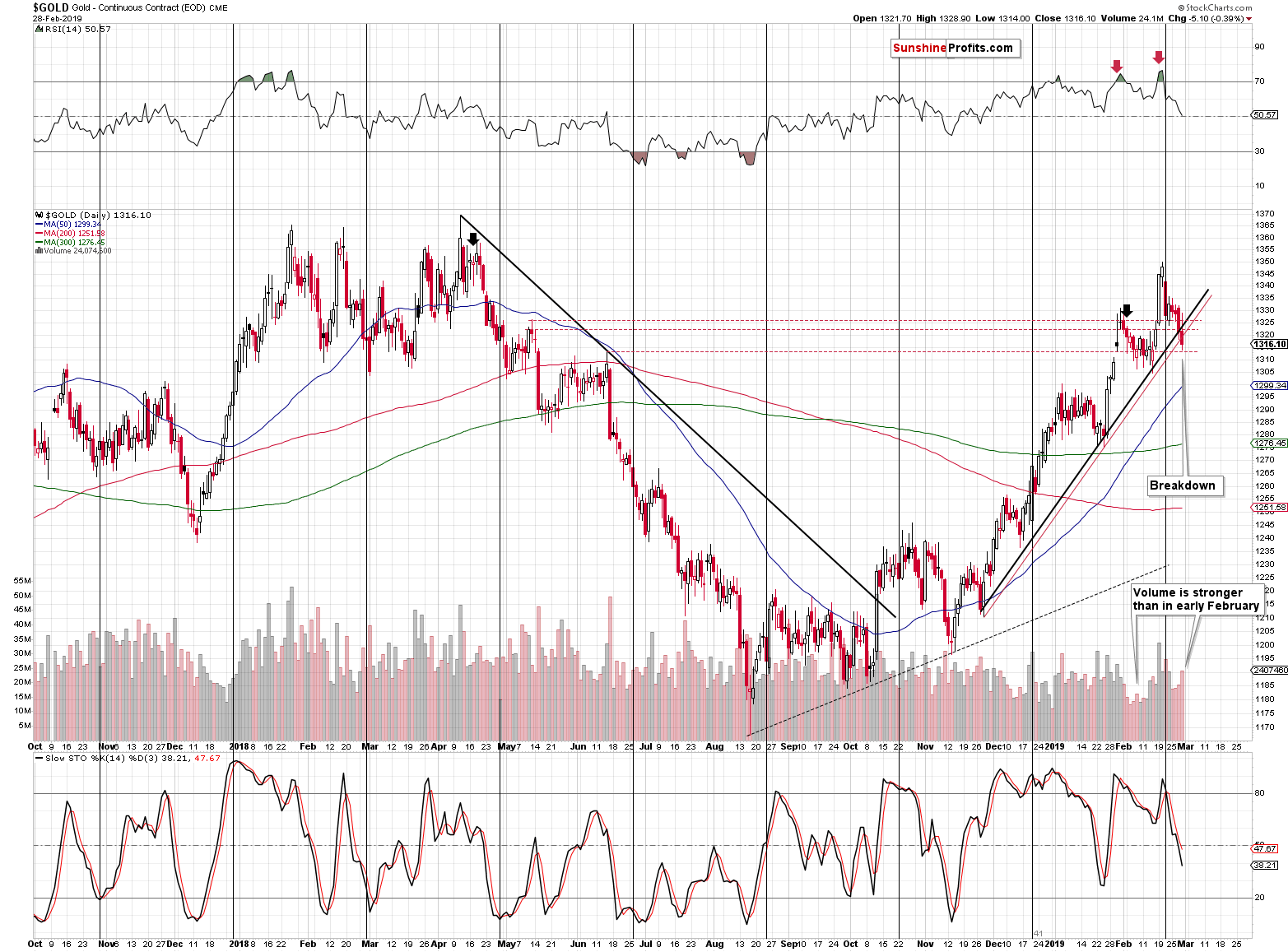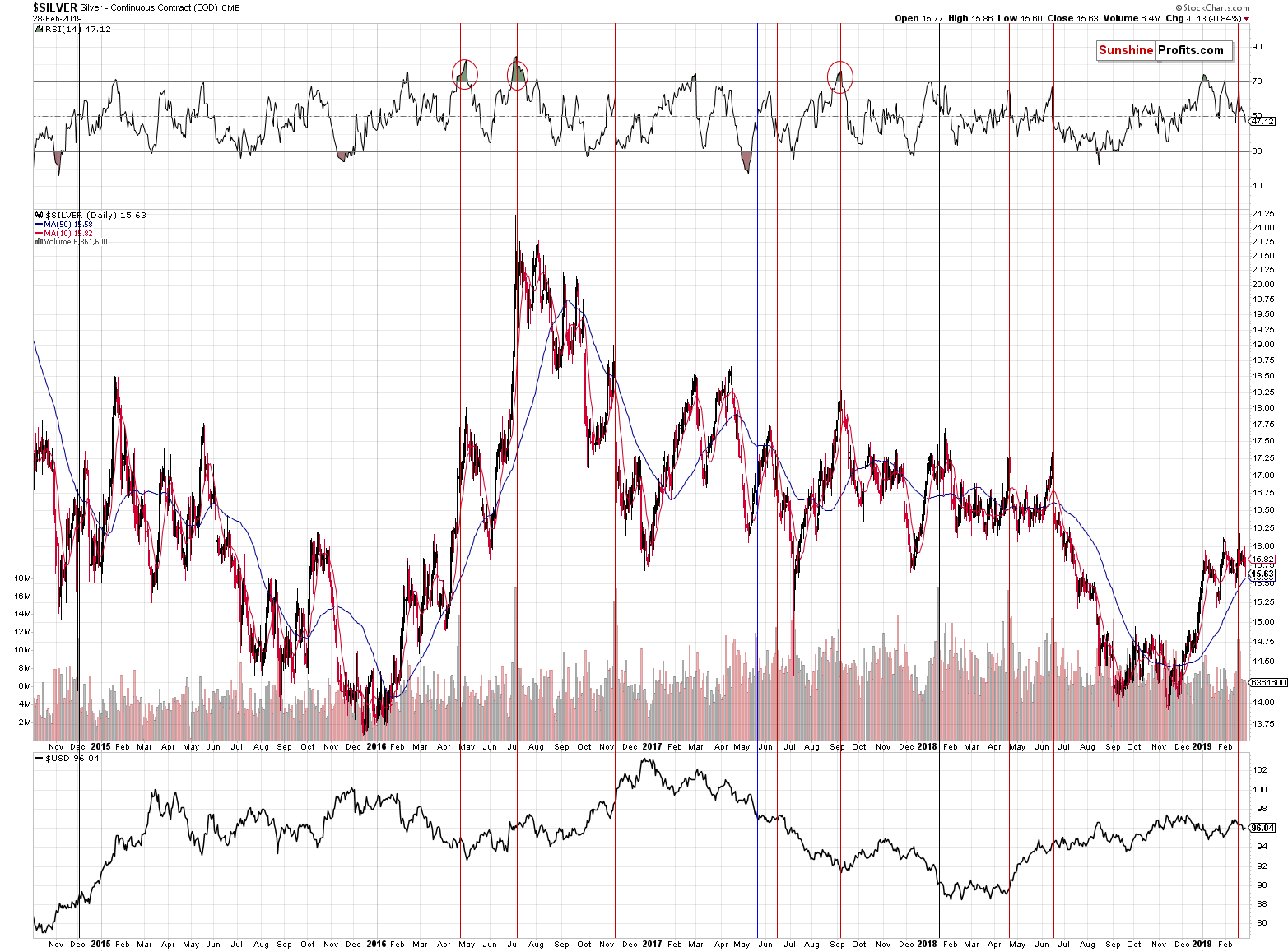Briefly: in our opinion, full (250% of the regular size of the position) speculative short position in gold, silver, and mining stocks is justified from the risk/reward perspective at the moment of publishing this Alert. In other words, we are re-opening the short positions in gold and miners.
The USD Index once again didn’t do much. Yet again, precious metals showed weakness regardless thereof. Gold had no major reason to decline, and it did much more than just that. Gold broke below the rising support line based on the November and January lows. That’s very important, because mining stocks had broken below their own rising support line earlier this week. Given today’s pre-market move lower in gold and silver it seems that these moves are far from accidental. Conversely, they change a lot.
Let’s jump right into charts. Before moving to the metals and miners, let’s take a quick look at the USD Index. The examination will be quick indeed, because the USD Index closed yesterday’s session unchanged and we simply want to emphasize that what we wrote yesterday, remains up-to-date:
The Cues from the USD Index
(…) the USD Index moved higher after forming an intraday low. The shape of the move is bullish, but the size thereof is very small (the USDX ended the session only 0.17 higher). Interestingly, this makes the implications of yesterday’s session more bearish. Why? Because a tiny move in the USDX was the only thing that it took for the whole precious metals complex to move considerably lower on a daily basis.
In yesterday’s analysis, we wrote the following:
“The intraday performance looks like the miners really wanted to move and break lower, but the declining USD Index simply didn’t let them do so.”
The tiny move higher in the USDX allowed for the decline in the PMs and the latter definitely took advantage of it. This is something profoundly bearish.
Yesterday’s action confirms that metals and miners wanted to move lower sooner, but the action in the USD Index simply didn’t allow them to do that. But it changed. Metals and miners are declining even without USD’s help, so when the latter rallies once again, the former are likely to truly plunge.
The Gold Miners: Breakdown in the Making
We intentionally didn’t change the title of the mining stock section, as the breakdown is still being verified in terms of the rule regarding the closing prices. Yesterday, we saw the second daily close below the rising support line. We would normally wait for miners to close below this line for the third day as well, before saying that the breakdown is indeed confirmed, but we saw additional confirmations from gold and from today’s pre-market action.
Gold’s Breakdown
Let’s start with quoting our yesterday’s comments on gold:
(...) The price of gold has definitely reversed at its cyclical turning point and we saw a daily close back below the January high and the mid-May high. However, there was still no breakdown below the rising support line – just a move to it, and then a small comeback higher. Consequently, the short-term outlook is more bearish than it was yesterday, but not strongly so.
The volume accompanying this gold decline was higher than what we saw in early February, and thus the bearish case appears stronger, especially when we bring the current gold-USD perspective into the picture.
Today, we have seen much more decisive signals from both: price and volume.
Price, because gold declined below the rising support lines. There are actually two lines, one based on daily closing prices (marked with black), and the second based on the intraday lows (marked with red). Gold broke below both. The breakdown took place on relatively big volume, and – more importantly – without any help from the USD. This shows great weakness of the gold market right now.
Since gold reversed at its cyclical turning point, several days ago, it’s been providing us with bearish confirmations. Now, it’s now after the breakdown below the short-term support line and also below the highs that it reached at the multiple triangle-vertex-based reversal in late January. Actually, that was most likely the true top and gold was unlikely to rally higher after that time, but Fed’s dovish comments kind of forced it to do so. We are mentioning this, because this is a perfect example of how both: news and technicals impact the gold price action.
On the very short-term note, gold reacted, just like it had to – it moved higher in a response to bullish news. But, the size of the move was rather small compared to how much had changed, and the buying power dried up quickly. The entire post-news rally was then erased. Ultimately, we now have gold below the dovish-Fed-announcement levels and at the same time, the Fed’s approach hadn’t changed – or at least it is not publicly known that it had. The immediate reaction of gold was in line with expectations, but ultimately, it’s moving in tune with the technical factors.
This is what we saw on a short-term basis. And in the following weeks and months, we are very likely to see the same kind of thing from the medium-term point of view. Gold is likely to erase all recent gains and more. And it’s going to decline amid multiple bullish analyses appearing everywhere.

Gold is already lower today, suggesting that the move is only beginning.
Now, we can’t rule out another move higher if the USD Index actually declines to the declining black support line before reversing. But, if it does move in this way, then gold is not likely to exceed the previous high. That would build the right shoulder of the potential head-and-shoulders formation we see marked on the alternative daily chart examining gold below:

Given the relative weakness that we saw in the last few days, it seems that if the USDX declined, then a move higher back to the January highs and then a huge wave lower would be the likely scenario.
Based on the recent breakdown, however, an immediate move lower seems more likely, though.
Let’s turn to silver for more details.
Silver Concurs
Silver turned south right after it’s high-volume rally, just as we expected it do. The reason we write about it is not because we want to emphasize this technique’s usefulness, but to show you how much silver declined after similar signals in the past. In all recent cases (since 2015), analogous reversals that worked initially (the red lines) were followed by substantial declines. Two cases in mid-2016, one in late 2016, one in mid-2017, one in September 2017, and three in 2018 – they were almost all followed by price declines of more than 10%. The only exception was the April 2018 decline, when silver declined by about 7% before moving higher once again.
So far, during this decline, silver price declined by about 4%. The history tends to rhyme, so the above suggests that silver is just starting its decline, not ending it.

As far as silver’s long-term chart is concerned, our previous comments remain up-to-date:
We previously emphasized that silver may break above its very long-term declining resistance line, but it’s not likely that this move will be significant. And that’s what we see right now – we recently saw two weekly reversals and this week looks like it’s going to be the third one. Silver can ignore the general technical rules for a short period, but it will still follow them over time. This is what beginning silver investors and traders fail to grasp. The flagship example is that they are very often following silver “breakouts” instead of using them as sell signals if they are not accompanied by the same level of strength in gold and miners. Moving back to the current picture, it seems that silver rally ended and that we will not have to wait long for the sharp drop in the silver prices to happen.
Summary
Summing up, we saw several bearish confirmations in the precious metals sector and in its reaction toward the (lack of) USD movement and based on them it seems that it’s justified to reenter the short positions in gold and mining stocks. Consequently, at this time, we think that a full speculative short position throughout the PMs complex is justified from the risk to reward point of view.
Please note that since the medium-term trend remains unaffected by the recent developments and the downside target remains intact (about $890 for gold), the precious metals market is likely to erase everything that it had gained in the last several days, weeks, and months, before THE bottom is in.
As always, we’ll keep you – our subscribers – informed.
To summarize:
Trading capital (supplementary part of the portfolio; our opinion): Full short position (250% of the full position) in gold, silver, and mining stocks is justified from the risk/reward perspective with the following stop-loss orders and exit profit-take price levels:
- Gold: profit-take exit price: $1,062; stop-loss: $1,357; initial target price for the DGLD ETN: $82.96; stop-loss for the DGLD ETN $39.87
- Silver: profit-take exit price: $12.32; stop-loss: $16.44; initial target price for the DSLV ETN: $47.67; stop-loss for the DSLV ETN $23.68
- Mining stocks (price levels for the GDX ETF): profit-take exit price: $13.12; stop-loss: $24.17; initial target price for the DUST ETF: $76.87; stop-loss for the DUST ETF $15.47
Note: the above is a specific preparation for a possible sudden price drop, it does not reflect the most likely outcome. You will find a more detailed explanation in our August 1st Alert. In case one wants to bet on junior mining stocks’ prices (we do not suggest doing so – we think senior mining stocks are more predictable in the case of short-term trades – if one wants to do it anyway, we provide the details), here are the stop-loss details and target prices:
- GDXJ ETF: profit-take exit price: $17.52; stop-loss: $35.67
- JDST ETF: initial target price: $143.87 stop-loss: $30.97
Long-term capital (core part of the portfolio; our opinion): No positions (in other words: cash)
Insurance capital (core part of the portfolio; our opinion): Full position
Important Details for New Subscribers
Whether you already subscribed or not, we encourage you to find out how to make the most of our alerts and read our replies to the most common alert-and-gold-trading-related-questions.
Please note that the in the trading section we describe the situation for the day that the alert is posted. In other words, it we are writing about a speculative position, it means that it is up-to-date on the day it was posted. We are also featuring the initial target prices, so that you can decide whether keeping a position on a given day is something that is in tune with your approach (some moves are too small for medium-term traders and some might appear too big for day-traders).
Plus, you might want to read why our stop-loss orders are usually relatively far from the current price.
Please note that a full position doesn’t mean using all of the capital for a given trade. You will find details on our thoughts on gold portfolio structuring in the Key Insights section on our website.
As a reminder – “initial target price” means exactly that – an “initial” one, it’s not a price level at which we suggest closing positions. If this becomes the case (like it did in the previous trade) we will refer to these levels as levels of exit orders (exactly as we’ve done previously). Stop-loss levels, however, are naturally not “initial”, but something that, in our opinion, might be entered as an order.
Since it is impossible to synchronize target prices and stop-loss levels for all the ETFs and ETNs with the main markets that we provide these levels for (gold, silver and mining stocks – the GDX ETF), the stop-loss levels and target prices for other ETNs and ETF (among other: UGLD, DGLD, USLV, DSLV, NUGT, DUST, JNUG, JDST) are provided as supplementary, and not as “final”. This means that if a stop-loss or a target level is reached for any of the “additional instruments” (DGLD for instance), but not for the “main instrument” (gold in this case), we will view positions in both gold and DGLD as still open and the stop-loss for DGLD would have to be moved lower. On the other hand, if gold moves to a stop-loss level but DGLD doesn’t, then we will view both positions (in gold and DGLD) as closed. In other words, since it’s not possible to be 100% certain that each related instrument moves to a given level when the underlying instrument does, we can’t provide levels that would be binding. The levels that we do provide are our best estimate of the levels that will correspond to the levels in the underlying assets, but it will be the underlying assets that one will need to focus on regarding the signs pointing to closing a given position or keeping it open. We might adjust the levels in the “additional instruments” without adjusting the levels in the “main instruments”, which will simply mean that we have improved our estimation of these levels, not that we changed our outlook on the markets. We are already working on a tool that would update these levels on a daily basis for the most popular ETFs, ETNs and individual mining stocks.
Our preferred ways to invest in and to trade gold along with the reasoning can be found in the how to buy gold section. Additionally, our preferred ETFs and ETNs can be found in our Gold & Silver ETF Ranking.
As a reminder, Gold & Silver Trading Alerts are posted before or on each trading day (we usually post them before the opening bell, but we don't promise doing that each day). If there's anything urgent, we will send you an additional small alert before posting the main one.
Thank you.
Sincerely,
Przemyslaw Radomski, CFA
Editor-in-chief, Gold & Silver Fund Manager







